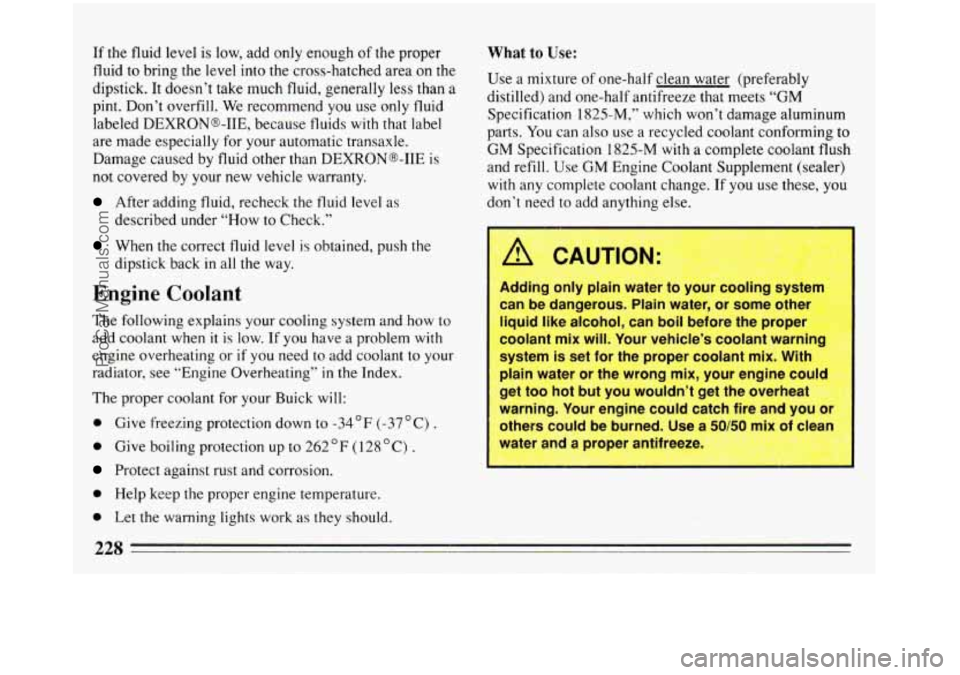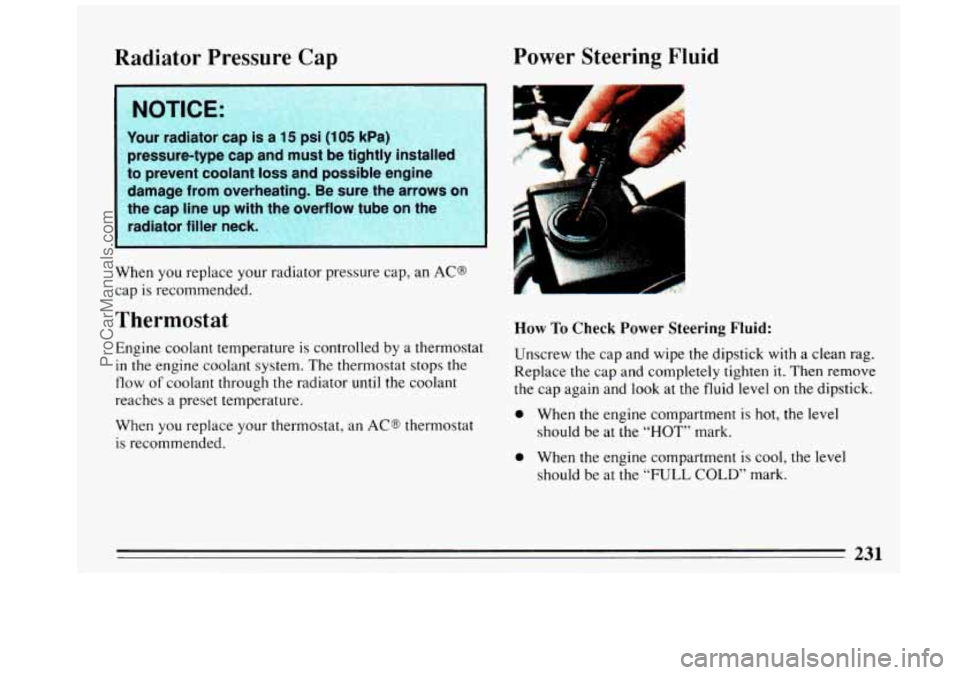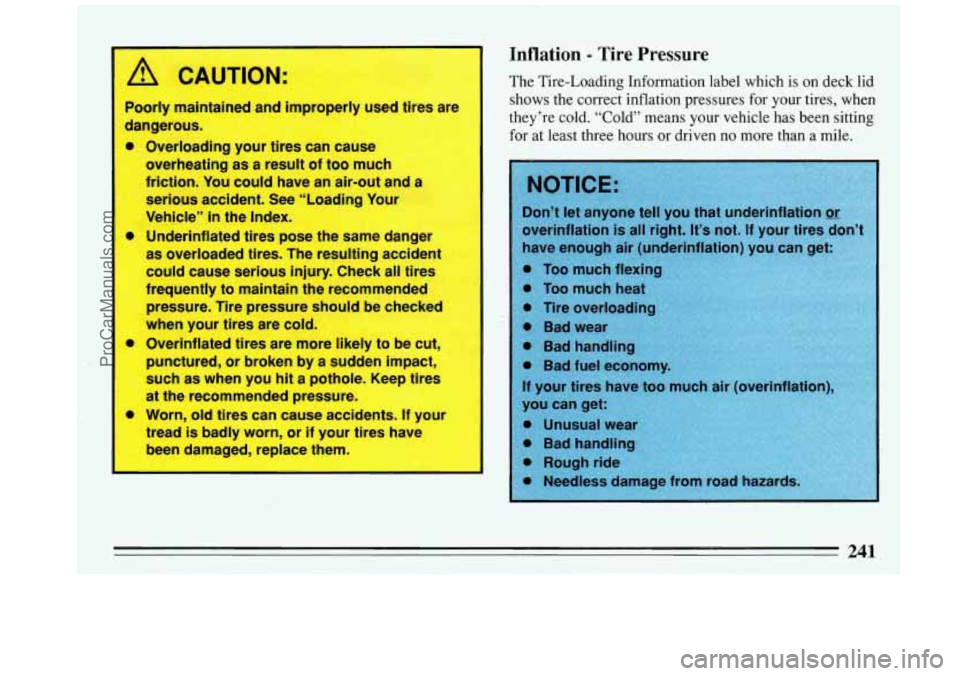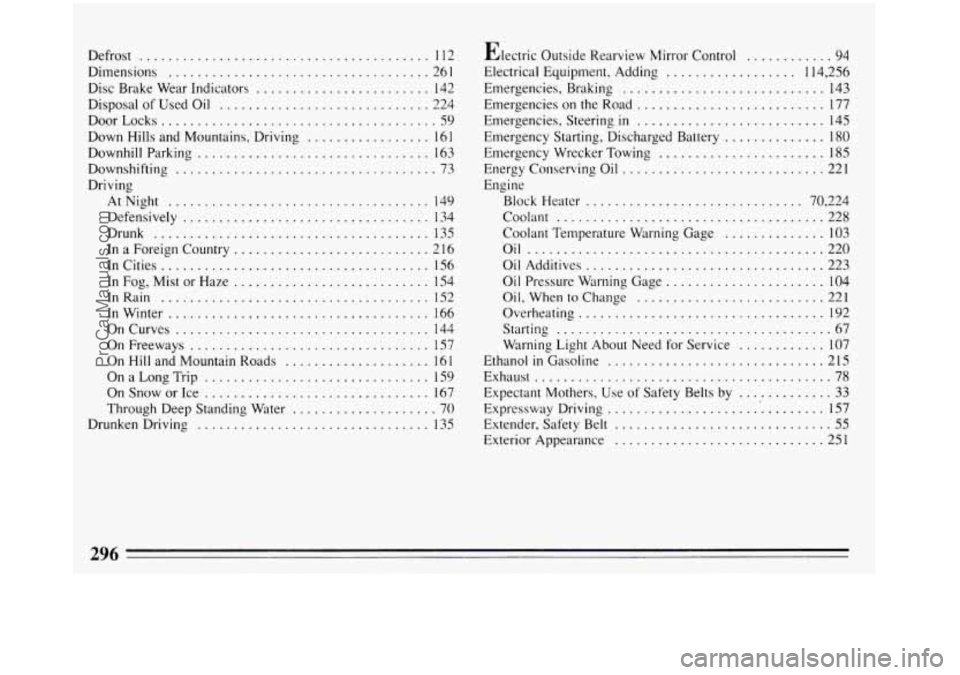1993 BUICK REGAL heating
[x] Cancel search: heatingPage 230 of 308

If the fluid level is low, add only enough of the proper
fluid to bring the level into the cross-hatched area on the
dipstick. It doesn’t take much fluid, generally less than a
pint. Don’t overfill. We recommend you use only fluid
labeled DEXRONB-IIE, because fluids with that label
are made especially for your automatic transaxle.
Damage caused by fluid other than DEXRONB-IIE is
not covered by your new vehicle warranty.
After adding fluid, recheck the fluid level as
described under “How
to Check.”
When the correct fluid level is obtained, push the
dipstick back in all the way.
Engine Coolant
The following explains your cooling system and how to
add coolant when
it is low. If you have a problem with
engine overheat.ing or if you need to add coolant to your
radiator, see “Engine Overheating”
in the Index.
The proper coolant for your Buick will:
0 Give freezing protection down to -34OF (-37OC) .
0 Give boiling protection up to 262 OF (128 “C) .
Protect against rust and corrosion.
0 Help keep the proper engine temperature.
0 Let the warning lights work as they should.
What to Use:
Use a mixture of one-half clean water (preferably
distilled) and one-half antifreeze that meets
“GM
Specification 1825-M,” which won’t damage aluminum
parts. You can also use a recycled coolant conforming to
GM Specification 1825-M with a complete coolant flush
and refill. Use GM Engine Coolant Supplement (sealer)
with any complete coolant change. If you use these, you
don’t need to add anything else.
can be aangerous. Plain water, or some other
liquid like alcohol, can boil before the proper
coolant mix will. Your vehicle’s coolant warning
system is set for the proper coolant mix. With
plain water or the wrong mix, your engine could
get too hot but you wouldn’t get the overhe-”
warning. Your engine could catch fire and
yuu or
others could be burned. Use a 50/50 mix of clean
water and a proper antifreeze.
G:~Z.+T~:, p:.t+d+s
228
ProCarManuals.com
Page 233 of 308

Radiator Pressure Cap rower Steerlng Fluid
1; NOTICE: 1
.:: Your radiator cap is a 15 psi (1 05 kPa)
:: pressure-type cap and must be tightly installed
,*to prevent coolant loss and possible engine
q:. damage from overheating. Be sure the arrows on
,. the cap line up with the overflow tube on the
8: radiator filfer neck.
When you replace your radiator pressure cap, an AC@
cap is recommended.
Thermostat
Engine coolant temperature is controlled by a thermostat
in the engine coolant system. The thermostat stops the
flow of coolant through the radiator until the coolant
reaches a preset temperature.
When you replace your thermostat, an
AC@ thermostat
is recommended.
L
How To Check Power Steering Fluid:
Unscrew the cap and wipe the dipstick with a clean rag.
Replace the cap and completely tighten
it. Then remove
the cap again and look at the fluid level on the dipstick.
0 When the engine compartment is hot, the level
should be at the
“HOT” mark.
0 When the engine compartment is cool, the level
should be at the
“FULL COLD” mark.
231
ProCarManuals.com
Page 243 of 308

A CAUTION:
Poorly maintained and improperly used tires are
dangerous.
0
Overloading your tires can cause
overheating as a result
of too much
friction. You could have an air-out and a
serious accident. See “Loading Your
Vehicle”
in the Index.
Underinflated tires pose the same danger
as overloaded tires. The resulting accident
could cause serious injury. Check all tires
frequently to maintain the recommended
pressure. Tire pressure should be checked
when your tires are cold.
Overinflated tires are more likely to be cut,
punctured, or broken by
a sudden impact,
such as when you
hit a pothole. Keep tires
at the recommended pressure.
Worn, old tires can cause accidents.
If your
tread
is badly worn, or if your tires have
been damaged, replace them.
Inflation - Tire Pressure
The Tire-Loading Information label which is on deck lid
shows the correct inflation pressures for your tires, when
they’re cold. “Cold” means your vehicle has been sitting
for at least three hours or driven
no more than a mile.
241
ProCarManuals.com
Page 298 of 308

Defrost ........................................ 112
Dimensions
.................................... 261
Disc Brake Wear Indicators
........................ 142
Disposal of Used Oil
............................. 224
DoorLocks
...................................... 59
Down Hills and Mountains. Driving
................. 16 1
Downhill Parking ................................ 163
Driving
Downshifting
.................................... 73
AtNight .................................... 149
Defensively
.................................. 134
Drunk
...................................... 135
In a Foreign Country
........................... 2 16
InCities
..................................... 156
In
Fog. Mist or Haze ........................... 154
InRain ..................................... 152
InWinter
.................................... 166
OnCurves ................................... 144
On Freeways
................................. 157
On Hill and Mountain Roads
.................... 16 1
On a Long Trip ............................... 159
On Snow or Ice
............................... 167
Through Deep Standing Water
.................... 70
Drunken Driving
................................ 135 Electric
Outside Rearview Mirror Control
............ 94.
Electrical Equipment. Adding .................. 114. 256
Emergencies. Braking
............................ 143
Etnergencies
on the Road .......................... 177
Emergencies. Steering
in .......................... 145
Emergency Starting. Discharged Battery
.............. 180
Emergency Wrecker Towing
....................... 185
Energy Conserving Oil ............................ 221
Engine
Block Heater
.............................. 70. 224
Coolant
..................................... 228
Coolant Temperature Warning Gage
.............. 103
Oil ......................................... 220
Oil Additives
................................. 223
Oil Pressure Warning Gage
...................... 104
Oil. When to Change .......................... 221
Starting
...................................... 67
Wa-ning Light About Need for Service ............ 107
Ethanol
in Gasoline .............................. 215
Exhaust
......................................... 78
Expectant Mothers. Use of Safety Belts by ............. 33
Expressway Driving .............................. 157
Extender. Safety Belt .............................. 55
Exterior Appearance
............................. 251
Overheating
.................................. 192
296
ProCarManuals.com
Page 302 of 308

Power Antenna Cleaning
............................. 124
DoorLocks
................................... 61
Mirrors
...................................... 94
Seat Controls
.................................. 15
Steering
..................................... 144
Steering Fluid
................................ 231
Windows
..................................... 79
Pregnancy. Use of Safety Belts During
................ 33
Pressure. Tire ................................... 241
Problems on the Road
............................ 177
Proper Safety Belt Usage. for Adults
.................. 26
Publications Order Form
.......................... 291
Publications. Service
............................. 288
Push-Starting Your Car
........................... 180
R (Reverse) Gear Position ......................... 71
Racing. Shifting When Your Engine is
................ 79
Radiator Pressure Cap ............................ 231
Radio. Two-way. Adding
a ........................ 1 14
Radio Systems
.................................. 1 13
Rain. Driving
in ................................. 152
Reaction Time
in Braking ......................... 139
Reading Lights
................................... 93
Rear Seat Console and Pass-Through
................. 98
Rear Window Defogger
........................... 113
Reclining Front Seatbacks
.......................... 16
Recommended Fluids and Lubricants
................ 280
Radiator Overheating ............................. 192 Recovery.
Off-Road
.............................. 146
Recreational Vehicle. Towing
a ..................... 170
Remote Keyless Entry System
....................... 62
Remote Trunk Release
............................. 61
Replaceable Light Bulbs .......................... 262
Replacing Brake System Parts
...................... 234
Replacing Safety Belts ............................. 56
Replacing Wheels ............................... 246
Reporting Safety Defects
.......................... 287
Restarting Your
Car When It’s Moving ................ 79
Restraint. Child
.................................. 42
Restraint Systems. Checking Your
.................... 55
Restraints. Head .................................. 17
Reverse Gear Position
.............................. 71
“Riding” the Brakes
.............................. 139
Roads. Hill and Mountain
.......................... 161
Rotation. Tire
................................... 242
Run (Ignition Key Position) ......................... 67
Running Lights. Daytime
........................... 92
Replacing
Tires
................................. 244
Roadsigns
..................................... 128
Rocking Your Vehicle
............................ 170
Running Your Engine While You’re Parked
............ 77
Safety Belt Care
................................ 251
Safety Belt Extender
.............................. 55
Safety Belt Reminder Light ......................... 25
Safety Belt Replacement ............................ 56
Safety Belt Usage by Adults
........................ 26
300
ProCarManuals.com